
|
||
|
Portland art blog + news + exhibition reviews + galleries + contemporary northwest art
|
||
Double Difference at Indivisible 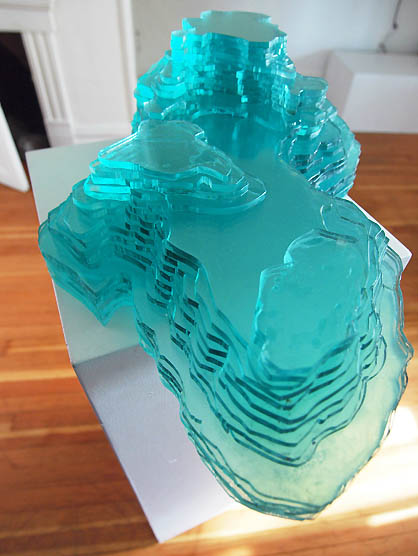 Linda Wysong, Hidden Topographies (2016) Linda Wysong and Linda K. Johnson have been been collaborating and executing co-orbital projects regarding the shifting and layered landscape of Portland for over 25 years. They find gravity in concrete, gravel and paved streetscapes and its roots are indebted to Robert Smithson and Co.'s fascination with the industrial ruins of Passaic New Jersey. Yet unlike their forbear prophets they continually focused on Portland. The result is a bit like running into an old miner who remembers the multiple gold rush times who can regale you with tales of claim jumpers, visionaries and hornswagglers. Except they are not swaggeling any horns. Wysong is a mapmaker at heart, dealing in topographies both mental and physical, Johnson is more of a documentary observer... perhaps like a historian only she's obsessed with the liminal dreams that history conjures. With rampant rent hikes in Portland's real estate + new developments pushing the destruction of historic homes and districts being a hot topic... this show about the material source of this construction is a dreamy poetic take on this hot topic (and frequently avoided programmatically by most of Portland's institutional curators). Though not terribly original the two do manage to make a compelling exhibition, "Double Difference"... one which leverages domestic and outdoor environments through the classic craftsmen style home that Indivisible as a venue encompasses. 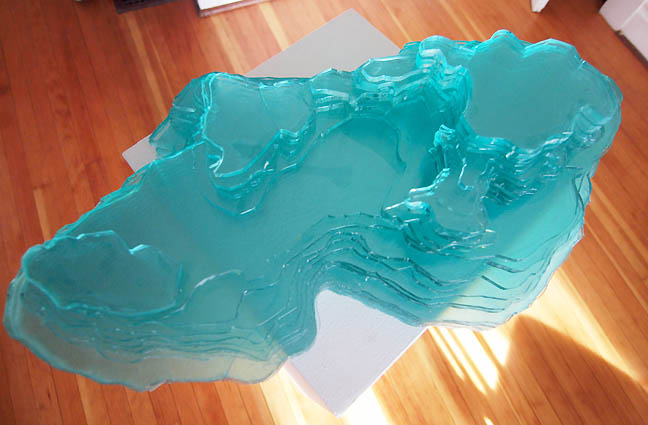 Hidden Topography (2016) The first piece one encounters is Wysong's Hidden Topography, a recent acrylic sculpture on a plinth of an inverted topography of the Ross Island Lagoon. The color is blue green, eerily reminiscent of the current and potentially health hazardous blue green algae bloom in the island's lagoon at the moment. It was a nice touch putting an inverted schematic of a body of water on a plinth that is smaller than the sculpture. It gives the art less of a sense of containment, bleeding into the domestic space of Indivisible. It is a major undercurrent of the show... Ross Island is so near to most Portlanders, centrally located yet a bit inaccessible. In a way it is like Alcatraz, except it is both a mining operation and a bit of a wildlife sanctuary. Ross Island is a series of contradictions. Technically it isnt even really one island so Wysong's focus on the lagoon is somewhat provocative since so much of what has been used to build Portland has come from mining this lagoon of sand and gravel to make concrete. We could think of the lagoon as an underwater clear cut, an inaccessible sometimes toxic oasis and the topographical heart of Portland as a city and an ecosystem. 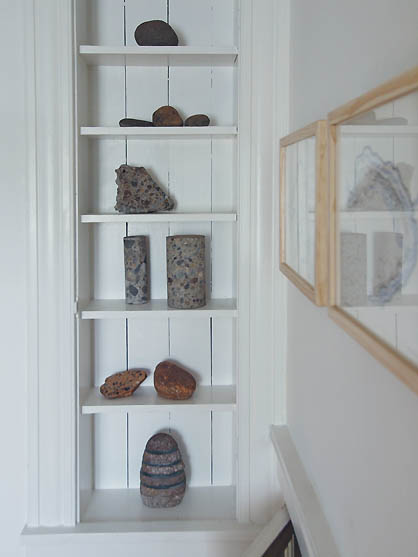 built in samples The mining of the island forms the essential bones of both domestic and commercial properties throughout Portland. A series of core samples of concrete placed upon built in cabinets at Indivisible bring this point home, literally. Somehow without the classic built ins these core samples wouldnt have the same impact. On the bottom rung a maquette for a sculpture devoted to the island can be found. Individually none really work as pieces of art but being placed in a built in like a bunch of family mementos it works.... nearby a few chunks of some building's foundation peak out from a storage space beneath the stairs... making the correlation even stronger. We are in a building whose foundation raw materials were likely mined from Ross Island. As a collective series of samples Wysong hasn't given them a name, are they to be considered art like the prints, video and sculpture in the show? This element of the show could have been given more focus and feels only half developed. At the same time it is where my mind wanders back to as I consider the show. To date nobody has fully used what Indivisible offers because they are too hidebound to gallery conventions. 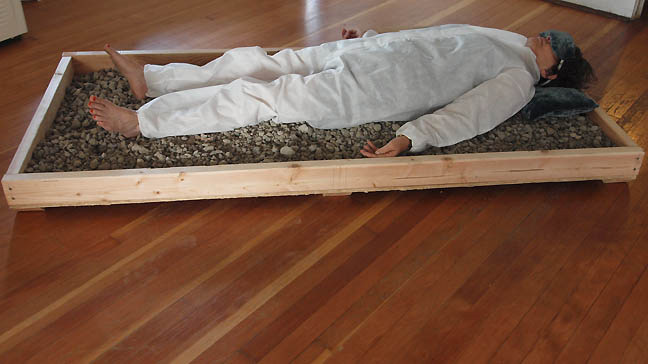 Linda K. Johnson's Demolition Dream Bed (2016) Linda K. Johnson's Demolition Dream Bed somewhat completes that circle though. The piece is an adaptation of Marina Abramovic's Dream Bed substituting the isolating down suit and plain box for one lined with the crushed cement from various recent demolitions in Portland. It comes from a company that recycles the demolition material. Visitors are encouraged to lie down upon this product and let their consciousness wander. A log book encourages the participants to share their experience. Overall it is very different from Abramovic's template and is more about getting in touch with the world than leaving it for some internal rem state. How do we feel? Nostalgia for a Portland that is sometimes needlessly disappearing, happiness for the repurposing of under used and neglected buildings? What is the true cost of recycling ruins? A few years ago Tori Abernathy did similar interesting things with similar materials. One truth is Portlanders frequently romanticize urban neglect and recycling for better and or ill but the piece does a good job of putting the participant in the crossfire of these two poles. Perchance participants will dream of something completely unrelated. Several other pieces by Johnson dont involve Portland and some like an edited text for a piece Tax Lot #1SE4ODD do (The piece was a temporary urban edible garden). 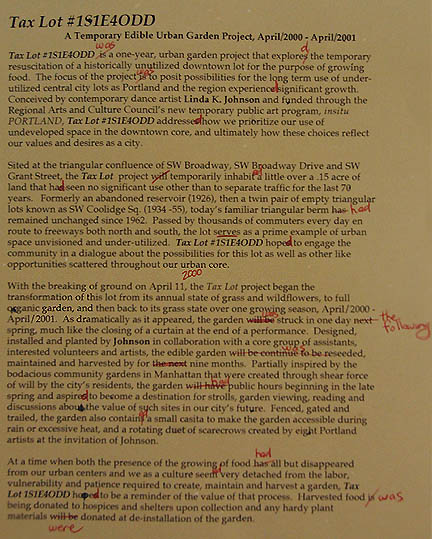
Perhaps that's part of the dream... a methodology inspired by Italo Calvino's book Invisible Cities... a palimpsest of activities one could apply to any place? I suppose it is for the sort who like to dream and assign themselves homework at the same time but without the domestic frame of Indivisible this exhibition would come off as too diffuse. With that frame it feels like watching someone practice scales on some instrument in a living room... not bad but still developing. 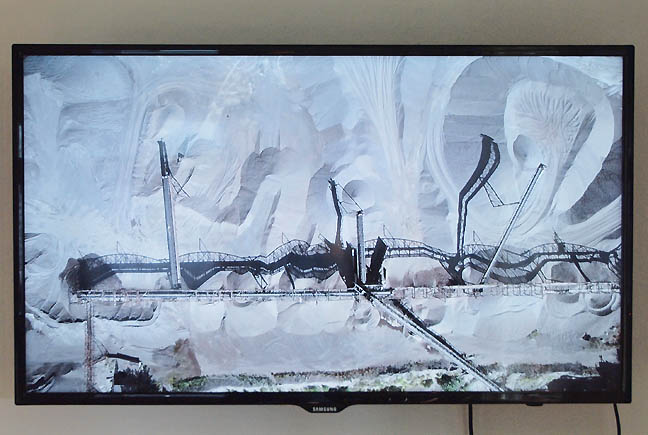
Second Look (2016) Also related is Linda Wysong's video collaboration Second Look with drone pilot Adam Simmons and editor Jodi Darby. It documents the slightly inaccessible island, demystifying it by presenting both its industry juxtaposed with somewhat more lightly used nature (its far from pristine). As a form of remote viewing it reminds one a bit of the text and video works of Robert Smithson and Nancy Holt... it is an important document but it feels like there is yet a more important piece about the island that could be made. As it is there is some gorgeous imagery and a lot of polarities between park-like scenes and resource extraction but it feels like more of a postcard for these things than anything else. The video reminds me that Ross Island itself is a kind of ruin. Ross Island isnt a castle overlooking the city but it functions in similar ways....at least to city dwellers, the birds and fish might feel differently. 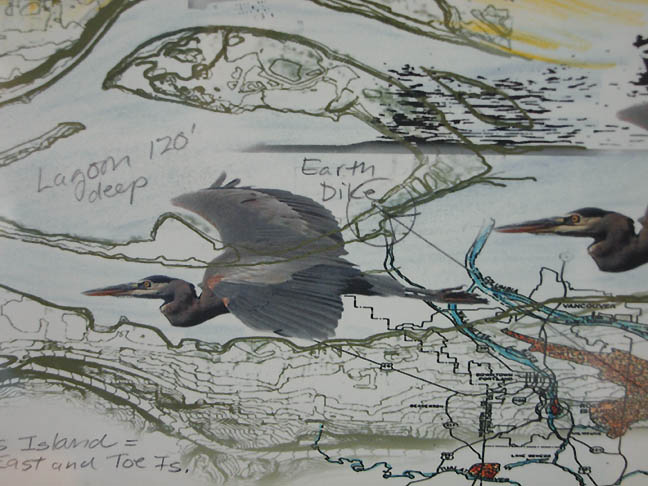 Detail of Linda Wysong's Backyard Conversations (2009) Other prints by Wysong like Backyard Conversations from PICA's 2009 festival feel like map-illustrations about the island as well. Without the context of Indivisible living room all would feel at tad undercooked. In a white box gallery space they might be more organized but also more brittle and the domestic setting gives them a supple, lived in quality... after all much of the work here is being represented. The exhibition is worth visiting an it is its last day. Double Difference isnt tight or even satisfying but it does open a conversation... one that so many group shows in Portland have utterly missed regarding our changing built environment. So much of the art in Portland over the past 10+ years has captured the way humans, the built environment and nature have danced, collided and sometimes obliterated each other yet curatorially most have avoided the scope and sweep of this dialog. Last day August 27th 2016, till 5:00PM @ Indivisible SE 26th Avenue between Clinton and Division Streets Posted by Jeff Jahn on August 27, 2016 at 11:00 | Comments (0) Comments Post a comment Thanks for signing in, . Now you can comment. (sign out)
(If you haven't left a comment here before, you may need to be approved by
the site owner before your comment will appear. Until then, it won't appear
on the entry. Thanks for waiting.)
|
| s p o n s o r s |
 |
 |
 |
 |
 |
 |
 |
 |
 |
 |
 |
 |
 |
 |
 |
 |

|
Site Design: Jennifer Armbrust | • | Site Development: Philippe Blanc & Katherine Bovee | |

